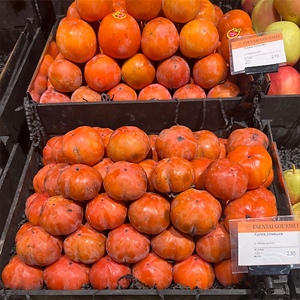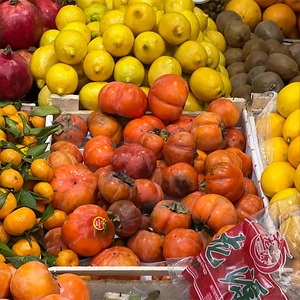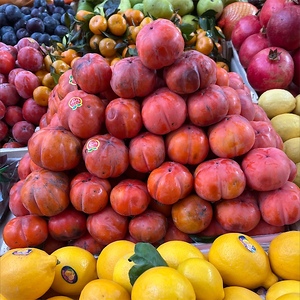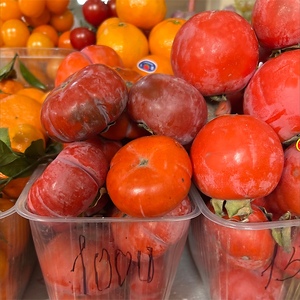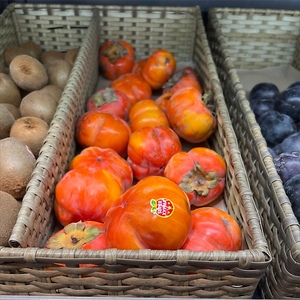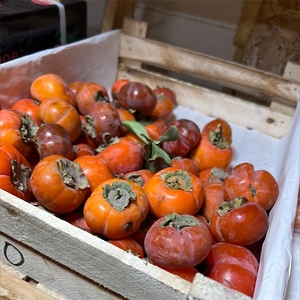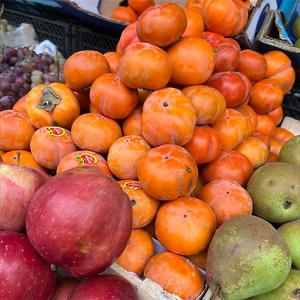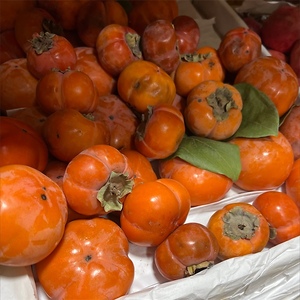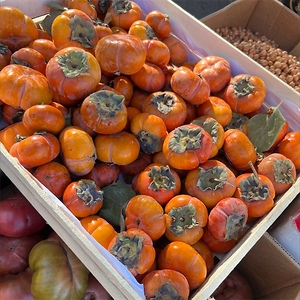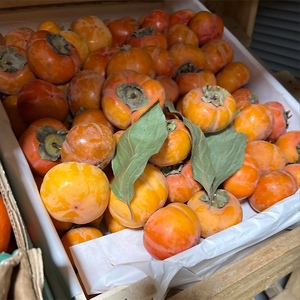


Chamomile Persimmons
Estimated Inventory, lb : 0
Description/Taste
Chamomile persimmons are squat to slightly flattened fruits, averaging 10 to 12 centimeters in diameter, and have a round, ovate shape with linear indentations forming multiple, curved sections. The skin is thin, smooth, and glossy, showcasing bright shades of orange and red, and on the top of the fruit, there is a prominent calyx comprised of a fibrous stalk and four papery and rough, green-brown leaves. Underneath the surface, the flesh is firm and dense when young, transitioning into a soft, viscous consistency when ripe. The orange flesh also develops brown tones when ripe, and depending on the individual fruit, the flesh may be seedless or encase several oblong to oval, dark brown seeds. Chamomile persimmons have a light and sweet, fig-like flavor, and the level of sweetness found in the flesh largely depends on the climate the fruit is grown in.
Seasons/Availability
Chamomile persimmons are available in the fall through early winter.
Current Facts
Chamomile persimmons, botanically classified as Diospyros kaki, are sweet fruits that grow on deciduous trees belonging to the Ebenaceae family. Also known as Fig persimmons, Chamomile persimmons are rumored to have received their name from their flower-like shape due to the linear indentations that resemble rounded petals on the surface of the fruit. Chamomile persimmons are an early-ripening cultivar and are somewhat astringent when young, developing a sweet, fleshy consistency when ripe. The unusually shaped fruits are challenging to find, primarily localized to fresh markets in central Asia, and are commonly consumed raw or incorporated into baked goods, jams, and desserts.
Nutritional Value
Chamomile persimmons are an excellent source of vitamin A, an antioxidant that contributes to eye health and can help boost the immune system. The fruits are also a good source of vitamin C to strengthen the immune system, manganese to maintain metabolism, and contain other nutrients, including calcium, potassium, vitamin E, fiber, and iron.
Applications
Chamomile persimmons are best suited for raw applications but can also be utilized in cooked preparations such as baking. When raw, the fruit can be sliced in half, scooped, and consumed fresh, out-of-hand, or the flesh can be blended into smoothies, drinks, and sauces. Chamomile persimmons can also be cooked into jams and jellies, pureed and blended into baked goods such as bread, pancakes, cakes, and pies, or dried for extended use. Chamomile persimmons pair well with nuts such as almonds, walnuts, and pistachios, honey, citrus, cheeses such as cottage, Manchego, mascarpone, and parmesan, ginger, and herbs such as basil and mint. Whole, unwashed fruits will keep for a couple of weeks when stored in the refrigerator.
Ethnic/Cultural Info
In Azerbaijan, persimmons have become one of the most cultivated and exported fruits, providing a significant source of sustainable income for the country. The fruits are exported mainly to Russia and other supplementary countries such as Kazakhstan, and local farmers and entrepreneurs created the Association of Persimmon Producers and Exporters in 2017 to help promote and streamline the persimmon production process. Marketing the fruits as “Made in Azerbaijan,” is beneficial as the country is known for its warm climate, which is prime persimmon growing conditions. Azerbaijan is also known for sweet-tasting fruits and is building new processing plants in order to dry and freeze persimmons for further exports. Of the total persimmon cultivation, only ten percent is sold locally within the country in both fresh and dried forms.
Geography/History
Chamomile persimmons are descendants of persimmon varieties native to the mountainous regions of China and have been cultivated for over two thousand years. The fruits were later spread to neighboring countries, including Japan and Korea via trade routes, and over time, persimmons arrived in the Black Sea region and into Russia approximately two hundred years ago. Since their introduction, persimmons have been widely cultivated, and new varieties were developed, such as Chamomile persimmons, to meet changing market demands. Today Chamomile persimmons are primarily grown through farms in central Asia, including Uzbekistan and Kazakhstan, and they are also cultivated in Azerbaijan and select regions in Russia.



